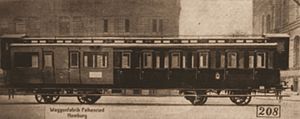Prussian VT 151
| Cologne 151 / Pr.ST.B. VT 151 / Pr.ST.B. VT 1 | |
|---|---|
|
Pr.ST.B.VT 1
|
|
| Numbering: | Cologne 151 Pr.ST.B. VT 151 Pr.ST.B. VT 1 |
| Number: | 1 |
| Manufacturer: | mech. Railway workshop Grunewald el. AEG |
| Year of construction (s): | 1908 |
| Axis formula : | (1A) '(A1)' |
| Gauge : | 1435 mm ( standard gauge ) |
| Length over buffers: | 16,960 mm |
| Trunnion Distance: | 9,000 mm |
| Bogie axle base: | 2,500 mm |
| Service mass: | unoccupied 37,850 kg occupied 43,000 kg |
| Top speed: | 50 km / h |
| Installed capacity: | 59 kW (80 PS) |
| Driving wheel diameter: | 1000 mm |
| Impeller diameter: | 1000 mm |
| Motor type: | Six-cylinder four-stroke petrol engine |
| Motor type: | Deutz |
| Rated speed: | 700 rpm |
| Power transmission: | electric |
| Number of traction motors: | 2 |
| Brake: | Westinghouse air brake |
| Seats: | 68 |
| Standing room: | 21st |
| Classes : | 3rd / 4th |
The VT 151 was a four-axle benzene-electric combustion railcar of the Prussian State Railways . It was the ancestor of all combustion railcars manufactured in Germany and was only used as a passenger railcar until 1910. The vehicle was then converted into a railway company car and continued to be used in this condition until around 1940.
history
During construction there was no comparable experience for the planned vehicle. Only a year before, the Prussian AT 1 was delivered as a three-axle vehicle as a battery -powered railcar.
Therefore, an existing passenger coach was used as a model for the VT 151 . On the part of AEG , who was primarily responsible for the construction , this was a passenger coach with five compartments. The car was designed as a four-axle vehicle to accommodate the underfloor machinery.
This vehicle was given the designation VT 151 according to the vehicle scheme valid around 1910 .
Prussian VT 1
The designation VT 1 was only introduced in 1913.
Precise information about the vehicle is not available. In the KPEV's booklets , only innovations in the drive design were mentioned about the vehicle, but no technical details. The railcar is said to have been tested on the Oranienburg test railway from 1908 . It should have broken the crankshaft . The testing phase lasted until the beginning of 1909.
The vehicle was then handed over to operations and is said to have been used on the routes around Homburg from March 1909 . Around 1910 the railcar was converted as a contact line investigation vehicle for the electrical test route Dessau-Bitterfeld . In 1914 it was presented in this modification variant at the Baltic Transport Exhibition in Malmö .
In the modified version, the railcar was still in operation for about three decades. At a point in time that cannot be specified, the machine system was converted from a gasoline engine to a diesel engine . Otherwise, the mechanical construction of the car body seems to have met the requirements; the drawings made in 1925 and 1940 show few changes to the original variant.
technical features
The car body was manufactured by the vehicle workshop in Falkenried , the bogies were supplied by G. Trelenburg in Breslau . Together with the benzene engine and the electrical equipment supplied by Deutz and AEG, the vehicle was completed in the Grunewald railway workshop . The car body resembled a conventional KPEV passenger car with a brakeman's cab in which the engine driver's cabs were placed. Approximately in the middle of the car was a door that led into the space above the benzene engine. There were 43 seats in 3rd carriage class and 25 in 4th carriage class for the passengers. The seats in the 3rd carriage class were housed in five compartments that were only accessible from the outside.
The machinery was arranged under the floor. No space had to be reserved in the car body for this, but it brought structural restrictions to the performance of the engine. The cylinders of the gasoline engine had a diameter of 150 mm and a stroke of 170 mm. The generator was a separately excited DC machine and delivered 75 kW per hour at 500 V. Two traction motors were suspended in the inner axles of the bogies, both of which had an hourly output of 36.7 kW (50 hp) each. The entire machine system was accessible via maintenance hatches.
See also
Web links
literature
- Günther Scheingraber: Battery powered rail car AT 7 , in: Eisenbahn-Journal Archiv 1/96 Volume No. 9 Prussia Report, ISBN 3-922404-84-7 .
Individual evidence
- ↑ a b c d Günther Scheingraber: Combustion railcar , in: Eisenbahn-Journal Archiv 1/96 Volume No. 9 Prussia Report, ISBN 3-922404-84-7 , page 43
- ↑ Günther Scheingraber: Combustion railcar , in: Eisenbahn-Journal Archiv 1/96 Volume No. 9 Prussia Report, ISBN 3-922404-84-7 , page 48
- ↑ Günther Scheingraber: Combustion railcar , in Eisenbahn-Journal Archiv 1/96 Volume No. 9 Prussia Report, ISBN 3-922404-84-7 , page 42
- ↑ a b Günther Scheingraber: Combustion railcar , in: Eisenbahn-Journal Archiv 1/96 Volume No. 9 Prussia Report, ISBN 3-922404-84-7 , page 44

